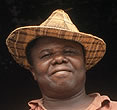

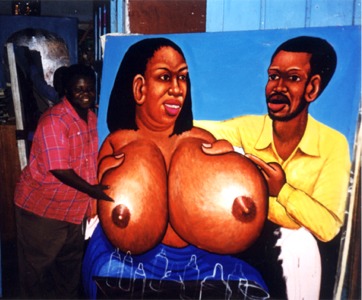
Moke the painter in his studio
in the Avenue Kasavubu, Kinshasa (Fotos by Prof.
Armin Prinz, Vienna, Austria).
Monsengwo
Kejwamfi, known as Moke the Painter, was born in 1950, in Ibe (province
of
Bandundu), Democratic Republic of Congo. Lived and worked in Kinshasa.
Died in
2001.
At the age of 10 he arrived in Kinshasa, decided to live in the
markets, and
survived by painting landscapes on cardboard boxes. He is considered to
be one
of fathers of "Zaire popular painting", for having as early as 1965
painted a picture representing General Mobutu waving to the crowds on
the
Boulevard du 30 Juin, as he led the parade commemorating Independence
Day. Seen
rightly as a "painter reporter" of city life, Moke set up his studio
at the crossroads of the main Kasavubu and Bolobo avenues and immersed
himself
in the daily life of the city from which he drew his inspiration. His
realistic
and vivacious painting reveals his meticulous observation of daily life
in
Kinshasa: street scenes, bar life, local dandies, rumbas and all-night
parties,
neighborhood disputes, public transportation, ceremonials, etc. Moke
paints
characters with round and full faces, with a black line separating each
of them,
without concern for likeness or even perspective. He uses hot, lively
industrial
colors, in a harmonious mixture that lends atmosphere and a particular
vigor to
his paintings. The theme he has chosen to develop is in the foreground,
the rest
of the picture is most often composed of "filler" characters that lack
detail. Moke structures his canvasses with great precision and
carefully
determines what part of the space the important elements will occupy.
Moke was a
true painter. On the night of September 26, 2001, Moke drank his last
Skol
Primus beer with Cheri Samba. All Kinshasa was deeply upset, it had
just lost
one of its most beloved figures.
(Text: CAACART)
Exhibitions: 1978 Academie des Beaux Arts, Kinshasa; 1979 Staatliche Kunsthalle Berlin and Bremen, Stockholm, Erlangen, Amsterdam, Frankfurt and London; 1982 Musee des Arts Decoratifs, Paris; 1985 Montreal University and Marius-Barbeau Museum, Gallery Trompe-l'oleil-Media Center Quebec; 1991 Liege and Museum of Contemporary Art, Chicago and Center for African Art, New York, Cobenhavn, Las Palmas and Gran Canaria; 1993 Bruxelles; 1995 Setagaya Art Museum, Tokyo, Himeci City Museum, Koriyama City Museum, Gifu; 1996 Palais des Beaux Arts, Charlesroi, 1997 Kinshasa and Galerie Peter Herrmann, Berlin; 2001 Bruxelles, Kinshasa and Paris; 2002 Geneva, Kinshasa and Bruxelles; 2008 "De Stadsschilders van Kinshasa", Hofke van Chantraine, Belgium; 2010 "O Congo. 50 ans d'independance en 50 tableaux", De Warande, Turnhout, Belgium; "Independance!", Musee Royal de l'Afrique Centrale, Tervuren/Brussels, Belgium; "50 Jahre Unabhängigkeit des Kongo in Bildern", Castle of Puchenau, Linz, Austria.
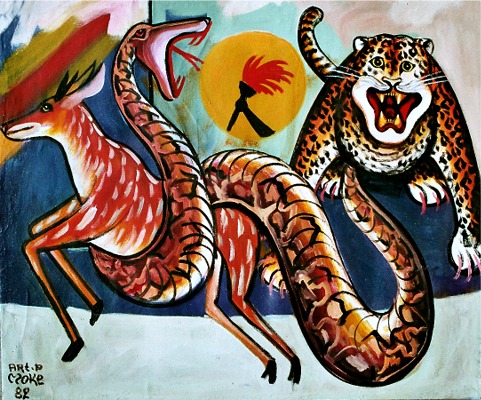
Allegorical Political Scene, oil on flour-sack, 82 x 100 cm, 1982
This is a very political painting: You see the sign of the MPR (Movement Populaire de la Revolution), which became the symbol on the official flag of Zaire. The leopard by the side of the sign represents president Mobutu. Moke sees him in 1982 as a protector, who saves the intellectual group of the country (the gazelle in the picture) from the threatening snake.
(In 1999 the Congolese painter Shula sees this issue differently: for him Mobutu is an evil dictator).
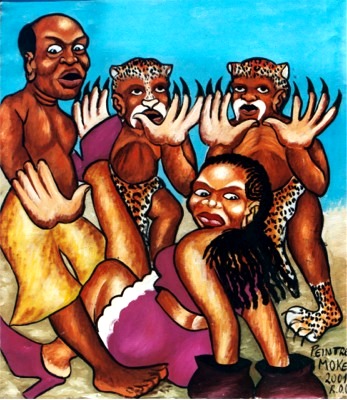
"Metamorphosis". Oil on flour-sack, 97 x 84 cm, 2001.
In the painting above Moke is illustrating an old legend: Bad people, especially those who committed rape, undergo partial or total metamorphosis and become transformed into the beasts they really were during their lifetime.
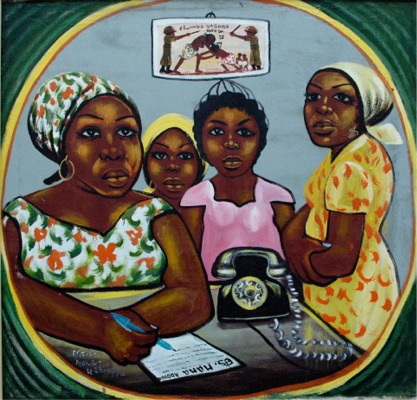
A classical image by Moke: "Women's Liberation Movement". Oil on flour-sack, 93 x 97 cm, 1976.